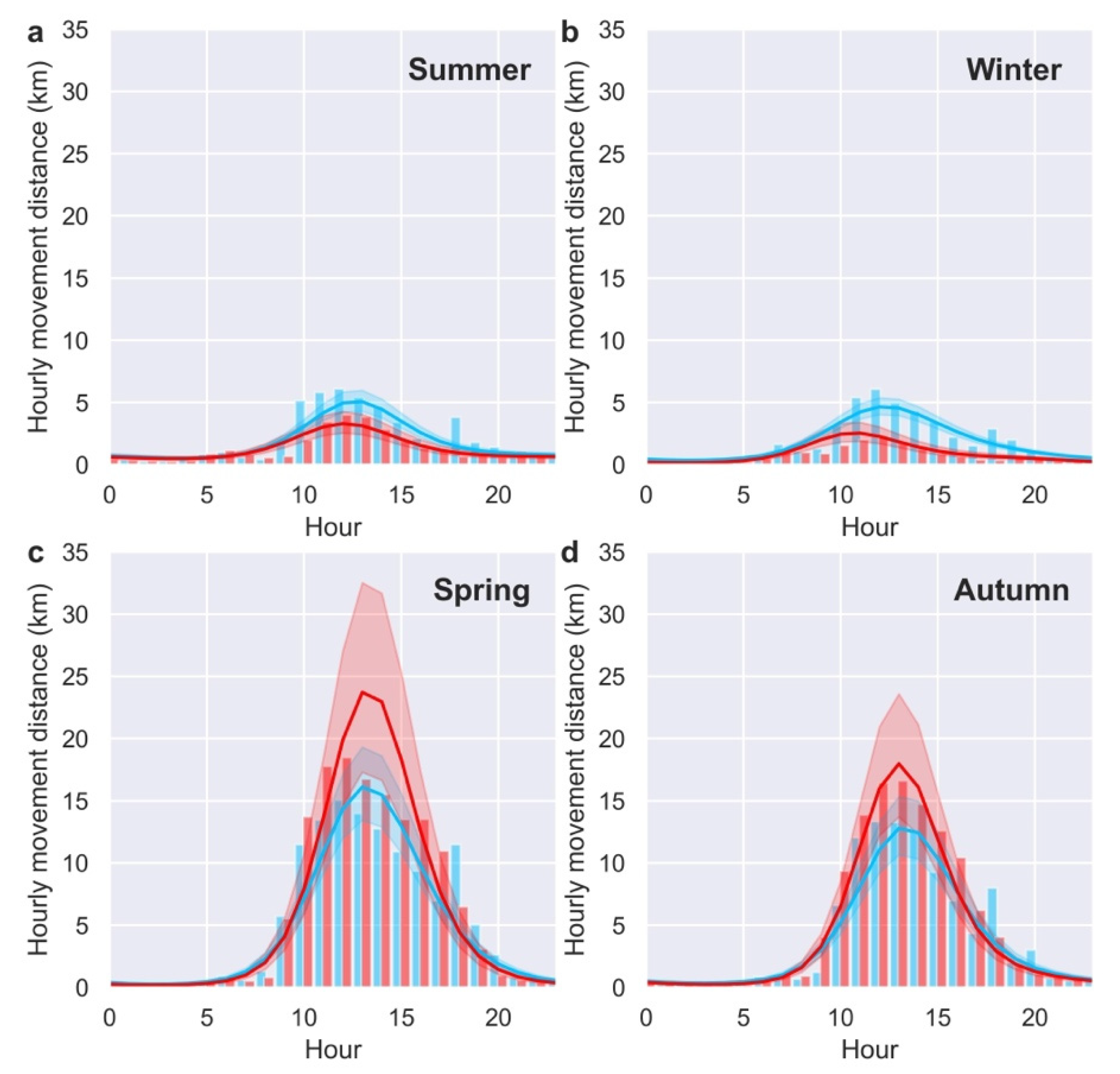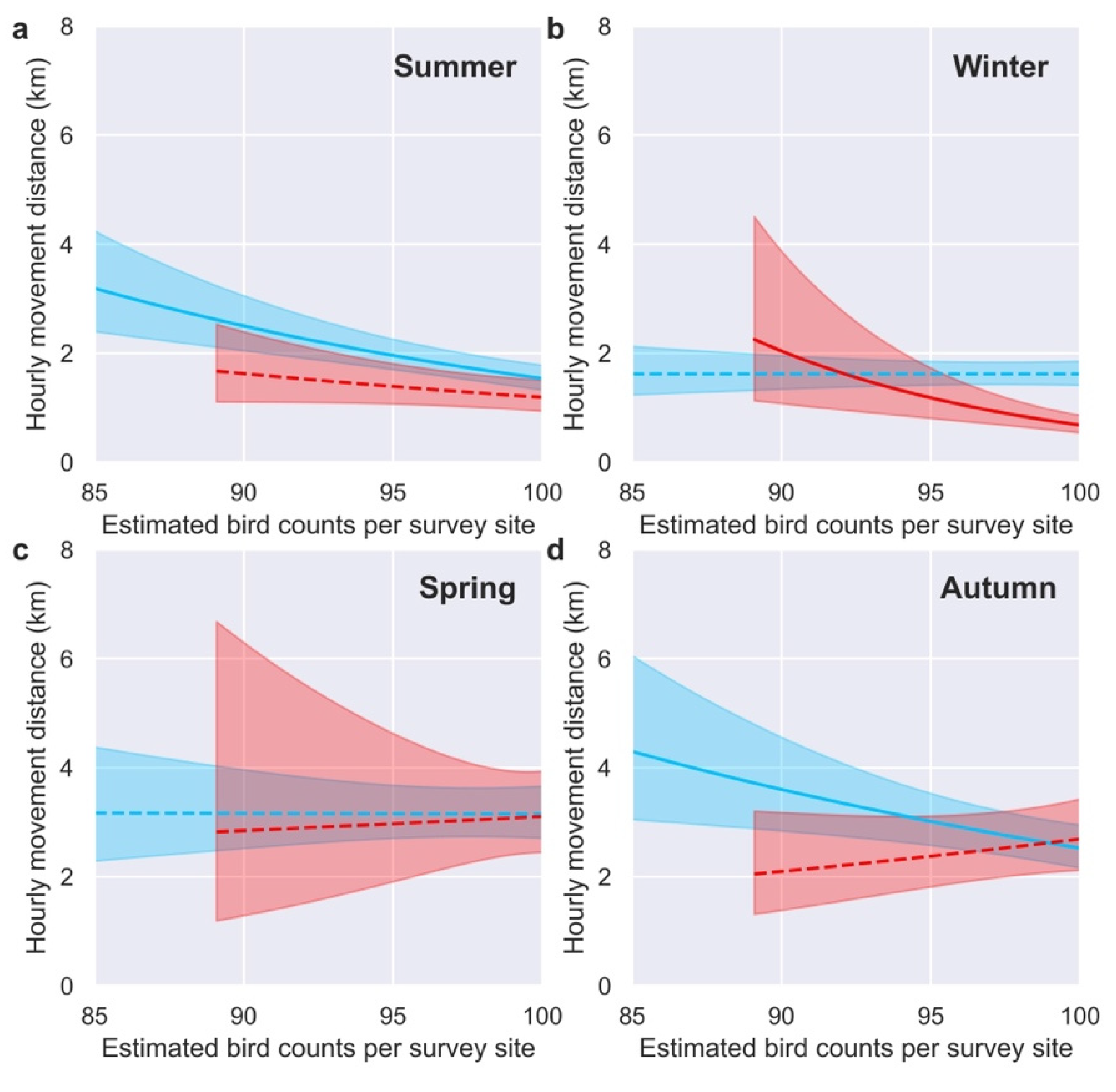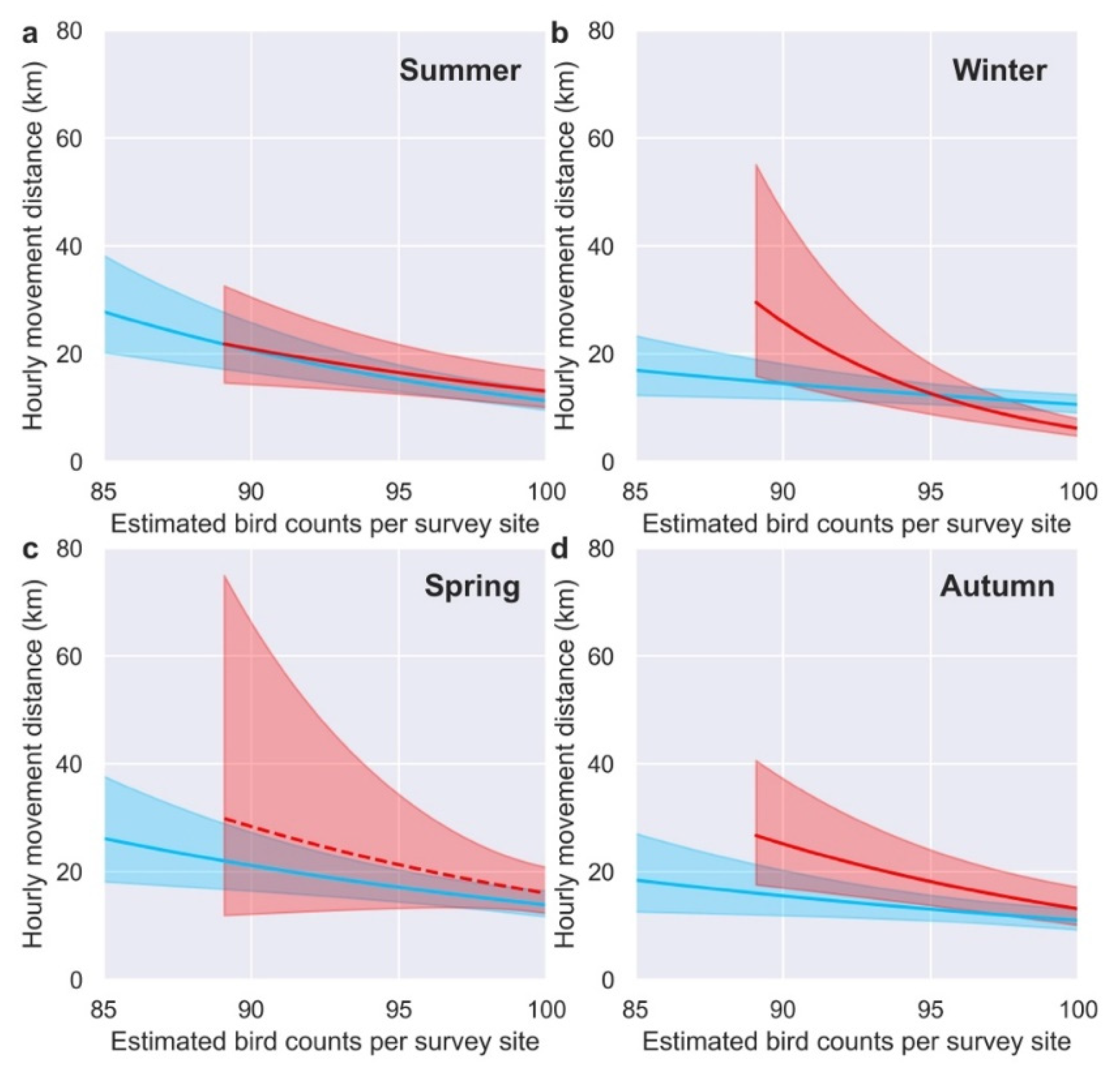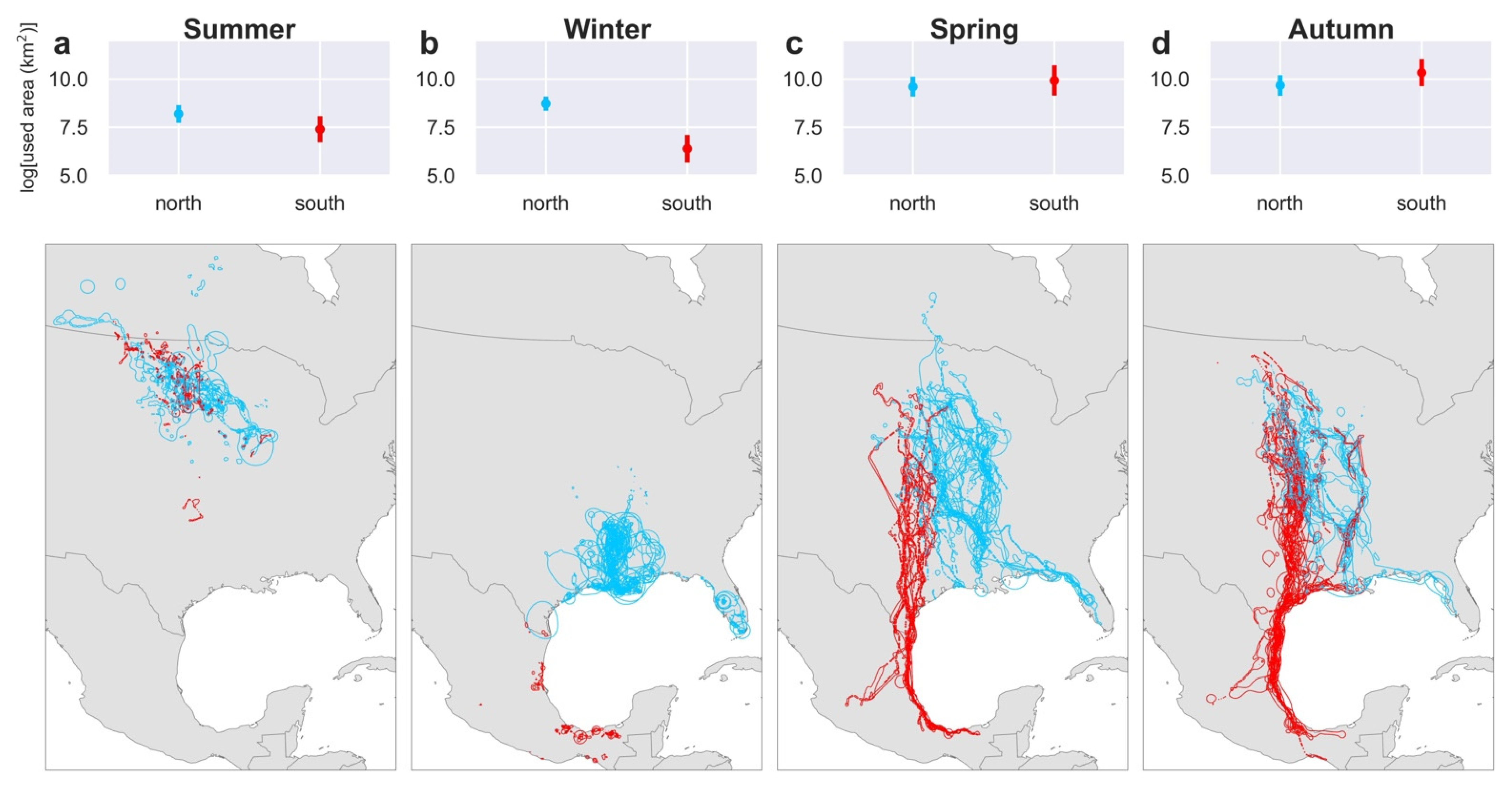Migratory Movements and Home Ranges of Geographically Distinct Wintering Populations of a Soaring Bird
Abstract
1. Introduction
2. Methods
2.1. Description of Study Regions
2.2. Capture Sites and Capture Methods
2.3. GPS Location, Christmas Bird Count, and Human Footprint Data Acquisition and Processing
3. Statistical Analyses
3.1. Daily Maximum and Average Hourly Movement Distance or Speed
3.2. Seasonal Home Range and Used Area on the Migratory Flyway
4. Results
4.1. Seasonal Hourly Movement Distance
4.2. Seasonal Maximum Hourly Movement Distance
4.3. Seasonal Home Range and Used Area on the Migratory Flyway
5. Discussion
6. Conclusions
Supplementary Materials
Author Contributions
Funding
Institutional Review Board Statement
Data Availability Statement
Acknowledgments
Conflicts of Interest
References
- Newton, I. The Migration Ecology of Birds; Elsevier: London, UK, 2008. [Google Scholar]
- Nathan, R.; Getz, W.M.; Revilla, E.; Holyoak, M.; Kadmon, R.; Saltz, D.; Smouse, P.E. A movement ecology paradigm for unifying organismal movement research. Proc. Natl. Acad. Sci. USA 2008, 105, 19052–19059. [Google Scholar] [CrossRef] [PubMed]
- Tøttrup, A.P.; Klaassen, R.H.G.; Strandberg, R.; Thorup, K.; Kristensen, M.W.; Jørgensen, P.S.; Fox, J.; Afanasyev, V.; Rahbek, C.; Alerstam, T. The annual cycle of a trans-equatorial Eurasian-African passerine migrant: Different spatio-temporal strategies for autumn and spring migration. Proc. R. Soc. B Biol. Sci. 2012, 279, 1008–1016. [Google Scholar] [CrossRef] [PubMed]
- Marra, P.P.; Cohen, E.B.; Loss, S.R.; Rutter, J.E.; Tonra, C.M. A call for full annual cycle research in animal ecology. Biol. Lett. 2015, 11, 20150552. [Google Scholar] [CrossRef] [PubMed]
- Winger, B.M.; Auteri, G.G.; Pegan, T.M.; Weeks, B.C. A long winter for the Red Queen: Rethinking the evolution of seasonal migration. Biol. Rev. 2019, 94, 737–752. [Google Scholar] [CrossRef] [PubMed]
- Nourani, E.; Yamaguchi, N. The effects of atmospheric currents on migratory behavior of soaring birds: A review. Ornithol. Sci. 2017, 16, 5–15. [Google Scholar] [CrossRef]
- Shamoun-Baranes, J.; Liechti, F.; Vansteelant, W.M.G. Atmospheric conditions create freeways, detours and tailbacks for migrating birds. J. Comp. Physiol. A 2017, 203, 509–529. [Google Scholar] [CrossRef] [PubMed]
- Hedenström, A.; Barta, Z.; Helm, B.; Houston, A.I.; McNamara, J.M.; Jonzén, N. Migration speed and scheduling of annual events by migrating birds in relation to climate change. Clim. Res. 2007, 35, 79–91. [Google Scholar] [CrossRef]
- Hedenström, A. Adaptations to migration in birds: Behavioural strategies, morphology and scaling effects. Philos. Trans. R. Soc. B Biol. Sci. 2008, 363, 287–299. [Google Scholar] [CrossRef]
- Blem, C.R. Energy balance. In Sturkie’s Avian Physiology, 5th ed.; Whittow, G.C., Ed.; Academic Press: San Diego, CA, USA, 2000; pp. 327–341. [Google Scholar]
- Duriez, O.; Kato, A.; Tromp, C.; Dell’Omo, G.; Vyssotski, A.L.; Sarrazin, F.; Ropert-Coudert, Y. How cheap is soaring flight in raptors? A preliminary investigation in freely-flying vultures. PLoS ONE 2014, 9, e84887. [Google Scholar] [CrossRef]
- Scacco, M.; Flack, A.; Duriez, O.; Wikelski, M.; Saf, K. Static landscape features predict uplift locations for soaring birds across Europe. R. Soc. Open Sci. 2019, 5, 181440. [Google Scholar] [CrossRef]
- McNab, B.K. Bioenergetics and the determination of home range size. Am. Nat. 1963, 97, 133–140. [Google Scholar] [CrossRef]
- Charnov, E. Optimal foraging, the marginal value theorem. Popul Biol. 1976, 9, 129–136. [Google Scholar] [CrossRef] [PubMed]
- McLoughlin, P.D.; Ferguson, S.H. A hierarchical pattern of limiting factors helps explain variation in home range size. Ecoscience 2000, 7, 123–130. [Google Scholar] [CrossRef]
- Ashmole, N.P. The regulation of numbers of tropical oceanic birds. Ibis 1963, 103, 458–473. [Google Scholar] [CrossRef]
- Weber, S.B.; Richardson, A.J.; Brown, J.; Bolton, M.; Clark, B.L.; Godley, B.J.; Leat, E.; Oppel, S.; Shearer, L.; Soetaert, K.E.; et al. Direct evidence of a prey depletion “halo” surrounding a pelagic predator colony. Proc. Natl. Acad. Sci. USA 2021, 118, e2101325118. [Google Scholar] [CrossRef]
- Tucker, M.A.; Böhning-Gaese, K.; Fagan, W.F.; Fryxell, J.M.; Van Moorter, B.; Alberts, S.C.; Ali, A.H.; Allen, A.M.; Attias, N.; Avgar, T.; et al. Moving in the Anthropocene: Global reductions in terrestrial mammalian movements. Science 2018, 469, 466–469. [Google Scholar] [CrossRef]
- Lilleyman, A.; Franklin, D.C.; Szabo, J.K.; Lawes, M.J. Behavioural responses of migratory shorebirds to disturbance at a high-tide roost. Emu-Austral. Ornithol. 2016, 116, 111–118. [Google Scholar] [CrossRef]
- Venter, O.; Sanderson, E.W.; Magrach, A.; Allan, J.R.; Beher, J.; Jones, K.R.; Possingham, H.P.; Laurance, W.F.; Wood, P.; Fekete, B.M.; et al. Global terrestrial human footprint maps for 1993 and 2009. Sci. Data 2016, 3, 160067. [Google Scholar] [CrossRef]
- Lawler, J.J.; Ruesch, A.S.; Olden, J.D.; Mcrae, B.H. Projected climate-driven faunal movement routes. Ecol. Lett. 2013, 16, 1014–1022. [Google Scholar] [CrossRef]
- Cabrera-Cruz, S.A.; Smolinsky, J.A.; Buler, J.J. Light pollution is greatest within migration passage areas for nocturnally-migrating birds around the world. Sci. Rep. 2018, 8, 3261. [Google Scholar] [CrossRef]
- Knopf, F.L.; Evans, R.M. American White Pelican (Pelecanus erythrorhynchos); The Birds of North America Online; Poole, A., Ed.; Cornell Lab of Ornithology: Ithaca, NY, USA, 2004. [Google Scholar]
- Shannon, H.D.; Young, G.S.; Yates, M.A.; Fuller, M.R.; Seegar, W.S. American white pelican soaring flight times and altitudes relative to changes in thermal depth and intensity. Condor 2002, 104, 679–683. [Google Scholar] [CrossRef]
- Butler, P.J.; Bishop, C.M. Flight. In Sturkie’s Avian Physiology, 5th ed.; Whittow, G.C., Ed.; Academic Press: San Diego, CA, USA, 2000; pp. 391–435. [Google Scholar]
- Pennycuick, C.J. Gliding Flight and Soaring. In Modelling the Flying Bird; Academic Press: London, UK, 2008; pp. 271–304. [Google Scholar]
- King, D.T.; Anderson, D.W. Recent population status of the American White Pelican: A continental perspective. Waterbirds 2005, 28, 48–54. [Google Scholar] [CrossRef][Green Version]
- Spalding, M.D.; Fox, H.E.; Allen, G.R.; Davidson, N.; Ferdaña, Z.A.; Finlayson, M.; Halpern, B.S.; Jorge, M.A.; Lombana, A.L.; Lourie, S.A.; et al. Marine ecoregions of the world: A bioregionalization of coastal and shelf areas. Bioscience 2007, 57, 573–583. [Google Scholar] [CrossRef]
- Wilkinson, T.; Wiken, E.; Creel, J.; Hourigan, T.; Agardy, T.; Herrmann, H. Marine Ecoregions of North America; Commission for Environmental Cooperation: Montreal, QC, Canada, 2009. [Google Scholar] [CrossRef]
- King, D.T.; Wang, G.; Yang, Z.; Fischer, J.W. Advances and environmental conditions of spring migration phenology of American white pelicans. Sci. Rep. 2017, 7, 40339. [Google Scholar] [CrossRef]
- Illan, J.G.; Wang, G.; Cunningham, F.L.; King, D.T. Seasonal effects of wind conditions on migration patterns of soaring American white pelican. PLoS ONE 2017, 12, e0186948. [Google Scholar] [CrossRef]
- Baldassarre, G.A.; Bolen, E.G. Major Waterfowl Habitats. In Waterfowl Ecology and Management, 2nd ed.; Krieger Publishing Company: Malabar, FL, USA, 2006; pp. 351–404. [Google Scholar]
- Thorhaug, A.L.; Poulos, H.M.; López-Portillo, J.; Barr, J.; Lara-Domínguez, A.L.; Ku, T.C.; Berlyn, G.P. Gulf of Mexico estuarine blue carbon stock, extent and flux: Mangroves, marshes, and seagrasses: A North American hotspot. Sci. Total Environ. 2019, 653, 1253–1261. [Google Scholar] [CrossRef]
- King, D.T.; Paulson, J.D.; Leblanc, D.J.; Bruce, K. Two capture techniques for American White Pelicans and Great Blue Herons. Colonial Waterbirds 1998, 21, 258–260. [Google Scholar] [CrossRef]
- King, D.T.; Fischer, J.; Strickland, B.; David, W.; Cunningham, F.L.; Wang, G. Winter and summer home ranges of American White Pelicans (Pelecanus erythrorhynchos) captured at loafing sites in the southeastern United States. Waterbirds 2016, 39, 287–294. [Google Scholar] [CrossRef][Green Version]
- Sovada, M.A.; Pietz, P.J.; Converse, K.A.; Tommy King, D.; Hofmeister, E.K.; Scherr, P.; Ip, H.S. Impact of West Nile virus and other mortality factors on American white pelicans at breeding colonies in the northern plains of North America. Biol. Conserv. 2008, 141, 1021–1031. [Google Scholar] [CrossRef][Green Version]
- Dorr, B.; King, D.T.; Harrel, J.B.; Gerard, P.; Spalding, M.G. The use of culmen length to determine sex of the American White Pelican. Waterbirds 2005, 28, 102–106. [Google Scholar] [CrossRef][Green Version]
- Dunstan, T.C. A harness for radio-tagging raptorial birds. Inland Bird. Band. News. 1972, 44, 4–8. [Google Scholar]
- Bunnefeld, N.; Börger, L.; Van Moorter, B.; Rolandsen, C.M.; Dettki, H.; Solberg, E.J.; Ericsson, G. A model-driven approach to quantify migration patterns: Individual, regional and yearly differences. J. Anim. Ecol. 2011, 80, 466–476. [Google Scholar] [CrossRef] [PubMed]
- Calenge, C. The package “adehabitat” for the R software: A tool for the analysis of space and habitat use by animals. Ecol. Modell. 2006, 197, 516–519. [Google Scholar] [CrossRef]
- National Audubon Society. The Christmas Bird Count Historical Results [Online]. 2010. Available online: http://www.christmasbirdcount.org (accessed on 17 July 2018).
- Wood, S.; Scheipl, F. Package “gamm4”: Generalized Additive Mixed Models Using “mgcv” and “lme4”. 2017. Available online: https://CRAN.R-project.org/package=gamm4 (accessed on 4 December 2018).
- Link, W.A.; Sauer, J.R.; Niven, D.K. A hierarchical model for regional analysis of population change using Christmas Bird Count data, with application to the American Black Duck. Condor 2006, 108, 13–24. [Google Scholar] [CrossRef]
- Venter, O.; Sanderson, E.W.; Magrach, A.; Allan, J.R.; Beher, J.; Jones, K.R.; Possingham, H.P.; Laurance, W.F.; Wood, P.; Fekete, B.M.; et al. Last of the Wild Project, Version 3 (LWP-3): 2009 Human Footprint; NASA Socioeconomic Data and Applications Center (SEDAC): Palisades, NY, USA, 2018. [Google Scholar] [CrossRef]
- Hijmans, R.J. Geosphere: Spherical Trigonometry. R Package Version 1.5.7. 2017. Available online: https://cran.r-project.org/package=geosphere (accessed on 27 November 2018).
- Kranstauber, B.; Smolla, M.; Scharf, A.K. Move: Visualizing and Analyzing Animal Track Data. R Package Version 3.0.2. 2017. Available online: https://CRAN.R-project.org/package=move (accessed on 2 April 2019).
- Kranstauber, B.; Kays, R.; Lapoint, S.D.; Wikelski, M.; Safi, K. A dynamic Brownian bridge movement model to estimate utilization distributions for heterogeneous animal movement. J. Anim. Ecology 2012, 81, 738–746. [Google Scholar] [CrossRef]
- Faraway, J.J. Extending the Linear Model with R: Generalized Linear, Mixed Effects and Nonparametric Regression Models; CRC Press: Boca Raton, FL, USA, 2016. [Google Scholar]
- Burnham, K.P.; Anderson, D.R. Model Selection and Multimodel Inference: A Practical Information-Theoretic Approach, 2nd ed.; Springer: New York, NY, USA, 2002. [Google Scholar]
- Brooks, M.E.; Kristensen, K.; van Benthem, K.J.; Magnusson, A.; Berg, C.W.; Nielsen, A.; Skaug, H.J.; Machler, M.; Bolker, B.M. glmmTMB balances speed and flexibility among packages for zero-inflated generalized linear mixed modeling. R. J. 2017, 9, 378–400. [Google Scholar] [CrossRef]
- Bartoń, K. MuMIn: Multi-Model Inference. R Package Version 1.15.6. 2016. Available online: https://CRAN.R-project.org/package=MuMIn (accessed on 1 December 2020).
- Lenth, R. Emmeans: Estimated Marginal Means, Aka Least-Squares Means. R Package Version 1.3.5. 2019. Available online: https://CRAN.R-project.org/package=emmeans (accessed on 1 December 2020).
- Esri Inc. ArcGIS Pro (Version 2.2). 2019. Available online: https://www.esri.com/en-us/arcgis/products/arcgis-pro/overview (accessed on 19 June 2022).
- Eisaguirre, J.M.; Auger-Méthé, M.; Barger, C.P.; Lewis, S.B.; Booms, T.L.; Breed, G.A. Dynamic-parameter movement models reveal drivers of migratory pace in a soaring bird. Front. Ecol. Evol. 2019, 7, 1–14. [Google Scholar] [CrossRef]
- Anderson, C.M.; Gilchrist, H.G.; Ronconi, R.A.; Shlepr, K.R.; Clark, D.E.; Fifield, D.A.; Robertson, G.J.; Mallory, M.L. Both short and long distance migrants use energy-minimizing migration strategies in North American herring gulls. Mov. Ecol. 2020, 8, 1–12. [Google Scholar] [CrossRef]
- Schmaljohann, H. Proximate mechanisms affecting seasonal differences in migration speed of avian species. Sci. Rep. 2018, 8, 4106. [Google Scholar] [CrossRef]
- Gordo, O. Why are bird migration dates shifting? A review of weather and climate effects on avian migratory phenology. Clim Res. 2007, 35, 37–58. [Google Scholar] [CrossRef]
- Seyer, Y.; Gauthier, G.; Bêty, J.; Therrien, J.F.; Lecomte, N. Seasonal variations in migration strategy of a long-distance Arctic-breeding seabird. Mar. Ecol. Prog. Ser. 2021, 677, 1–16. [Google Scholar] [CrossRef]
- Richardson, P.L. How do albatrosses fly around the world without flapping their wings? Prog. Oceanogr. 2011, 88, 46–58. [Google Scholar] [CrossRef]
- Haskell, J.P.; Ritchie, M.E.; Olff, H. Fractal geometry predicts varying body size scaling relationships for mammal and bird home ranges. Nature 2002, 418, 527–530. [Google Scholar] [CrossRef] [PubMed]
- Williams, H.J.; Shepard, E.L.C.; Holton, M.D.; Alarcón, P.A.E.; Wilson, R.P.; Lambertucci, S.A. Physical limits of flight performance in the heaviest soaring bird. Proc. Natl. Acad. Sci. USA 2020, 117, 17884–17890. [Google Scholar] [CrossRef] [PubMed]
- Safi, K.; Kranstauber, B.; Weinzierl, R.; Griffin, L.; Rees, E.C.; Cabot, D.; Cruz, S.; Proaño, C.; Takekawa, J.Y.; Newman, S.H.; et al. Flying with the wind: Scale dependency of speed and direction measurements in modelling wind support in avian flight. Mov. Ecol. 2013, 1, 1–13. [Google Scholar] [CrossRef] [PubMed]
- García-Jiménez, R.; Pérez-García, J.M.; Margalida, A. Drivers of daily movement patterns affecting an endangered vulture flight activity. BMC Ecol. 2018, 18, 1–15. [Google Scholar] [CrossRef] [PubMed]
- Johnson, D.D.P.; Kays, R.; Blackwell, P.G.; Macdonald, D.W. Does the resource dispersion hypothesis explain group living? Trends Ecol. Evol. 2002, 17, 563–570. [Google Scholar] [CrossRef]
- Marable, M.K.; Belant, J.L.; Godwin, D.; Wang, G. Effects of resource dispersion and site familiarity on movements of translocated wild turkeys on fragmented landscapes. Behav. Processes 2012, 91, 119–124. [Google Scholar] [CrossRef]
- Wilson, S.; Saracco, J.F.; Krikun, R.; Flockhart, D.T.T.; Godwin, C.M.; Foster, K.R. Drivers of demographic decline across the annual cycle of a threatened migratory bird. Sci. Rep. 2018, 8, 7316. [Google Scholar] [CrossRef]
- Linssen, H.; Van De Pol, M.; Allen, A.M.; Jans, M.; Ens, B.J.; Krijgsveld, K.L.; Frauendorf, M.; Van der Kolk, H.J. Disturbance increases high tide travel distance of a roosting shorebird but only marginally affects daily energy expenditure. Avian Res. 2019, 10, 31. [Google Scholar] [CrossRef]
- Klaassen, R.H.G.; Hake, M.; Strandberg, R.; Koks, B.J.; Trierweiler, C.; Exo, K.M.; Bairlein, F.; Alerstam, T. When and where does mortality occur in migratory birds? Direct evidence from long-term satellite tracking of raptors. J. Anim. Ecol. 2014, 83, 176–184. [Google Scholar] [CrossRef] [PubMed]
- Village, A. The home range and density of kestrels in relation to vole abundance. J. Anim. Ecol. 1982, 51, 413–428. [Google Scholar] [CrossRef]
- Mace, G.M.; Harvey, P.H. Energetic constraints on home-range size. Am. Nat. 1983, 121, 120–132. [Google Scholar] [CrossRef]
- Anich, N.M.; Benson, T.J.; Bednarz, J.C. Factors influencing home-range size of Swainson’s Warblers in eastern Arkansas. Condor 2010, 112, 149–158. [Google Scholar] [CrossRef]
- Papageorgiou, D.; Farine, D.R. Group size and composition influence collective movement in a highly social terrestrial bird. eLife 2020, 9, e59902. [Google Scholar] [CrossRef] [PubMed]





| Model a,b | df c | ∆AIC d | AIC Weights e |
|---|---|---|---|
| (sin + cos) × ssn × g + ssn × g × cbc + hfp | 51 | 0.00 | 0.63 |
| (sin + cos) × ssn × g + ssn × g × cbc + ssn × hfp | 54 | 1.08 | 0.37 |
| (sin + cos) × ssn × g + ssn × g × cbc | 50 | 13.57 | 0.00 |
| (sin + cos) × ssn × g + ssn × cbc + hfp | 47 | 13.72 | 0.00 |
| (sin + cos) × ssn × g + (g + ssn) × cbc + hfp | 48 | 15.36 | 0.00 |
| (sin + cos) × ssn × g + cbc + hfp | 44 | 32.61 | 0.00 |
| (sin + cos) × ssn × g + g × cbc + hfp | 45 | 34.64 | 0.00 |
| (sin + cos) × ssn × g + hfp | 43 | 38.15 | 0.00 |
| (sin + cos) × (g + ssn) + ssn × g × cbc + hfp | 39 | 53.04 | 0.00 |
| (sin + cos) × ssn + ssn × g × cbc + hfp | 35 | 69.68 | 0.00 |
| (sin + cos) × g + ssn × g × cbc + hfp | 27 | 794.13 | 0.00 |
| (sin + cos) + ssn × g × cbc + hfp | 23 | 801.75 | 0.00 |
| Model a,b | df c | ∆AIC d | AIC Weight e |
|---|---|---|---|
| (sin + cos) × ssn × g + ssn × g × cbc + ssn × hfp | 54 | 0.00 | 0.37 |
| (sin + cos) × ssn × g + ssn × g × cbc | 50 | 0.11 | 0.35 |
| (sin + cos) × ssn × g + ssn × g × cbc + hfp | 51 | 0.66 | 0.27 |
| (sin + cos) × ssn × g + cbc | 43 | 7.71 | 0.01 |
| (sin + cos) × ssn × g + g × cbc | 44 | 8.16 | 0.01 |
| (sin + cos) × ssn × g + ssn × cbc | 46 | 11.89 | 0.00 |
| (sin + cos) × ssn × g + (g + ssn) × cbc | 47 | 12.45 | 0.00 |
| (sin + cos) × (g + ssn) + ssn × g × cbc | 38 | 19.46 | 0.00 |
| (sin + cos) × ssn + ssn × g × cbc | 34 | 34.22 | 0.00 |
| (sin + cos) × ssn × g | 42 | 45.19 | 0.00 |
| (sin + cos) × g + ssn × g × cbc | 26 | 322.99 | 0.00 |
| (sin + cos) + ssn × g × cbc | 22 | 330.48 | 0.00 |
| Model a,b | df c | ∆AIC d | AIC Weight e |
|---|---|---|---|
| ssn × g + g × cbc + hfp | 13 | 0.00 | 0.54 |
| ssn × g + cbc + hfp | 12 | 1.17 | 0.30 |
| ssn × g + g × cbc + ssn × cbc + hfp | 16 | 3.78 | 0.08 |
| ssn × g + ssn × cbc + hfp | 15 | 5.56 | 0.03 |
| ssn × g + hfp | 11 | 5.73 | 0.03 |
| ssn × g × cbc + hfp | 19 | 9.40 | 0.00 |
| ssn × g × cbc + ssn × hfp | 22 | 10.78 | 0.00 |
| ssn × g | 10 | 29.51 | 0.00 |
| ssn × g × cbc | 18 | 38.49 | 0.00 |
| ssn + g × cbc + hfp | 10 | 45.58 | 0.00 |
| g × cbc + ssn × cbc + hfp | 13 | 47.41 | 0.00 |
| ssn + g | 7 | 70.94 | 0.00 |
Publisher’s Note: MDPI stays neutral with regard to jurisdictional claims in published maps and institutional affiliations. |
© 2022 by the authors. Licensee MDPI, Basel, Switzerland. This article is an open access article distributed under the terms and conditions of the Creative Commons Attribution (CC BY) license (https://creativecommons.org/licenses/by/4.0/).
Share and Cite
Ogawa, R.; Davis, J.B.; King, D.T.; Burger, L.W.; Strickland, B.K.; Sovada, M.A.; Wang, G.; Cunningham, F.L. Migratory Movements and Home Ranges of Geographically Distinct Wintering Populations of a Soaring Bird. Diversity 2022, 14, 1109. https://doi.org/10.3390/d14121109
Ogawa R, Davis JB, King DT, Burger LW, Strickland BK, Sovada MA, Wang G, Cunningham FL. Migratory Movements and Home Ranges of Geographically Distinct Wintering Populations of a Soaring Bird. Diversity. 2022; 14(12):1109. https://doi.org/10.3390/d14121109
Chicago/Turabian StyleOgawa, Ryo, J. Brian Davis, D. Tommy King, L. Wes Burger, Bronson K. Strickland, Marsha A. Sovada, Guiming Wang, and Fred L. Cunningham. 2022. "Migratory Movements and Home Ranges of Geographically Distinct Wintering Populations of a Soaring Bird" Diversity 14, no. 12: 1109. https://doi.org/10.3390/d14121109
APA StyleOgawa, R., Davis, J. B., King, D. T., Burger, L. W., Strickland, B. K., Sovada, M. A., Wang, G., & Cunningham, F. L. (2022). Migratory Movements and Home Ranges of Geographically Distinct Wintering Populations of a Soaring Bird. Diversity, 14(12), 1109. https://doi.org/10.3390/d14121109








